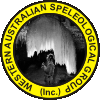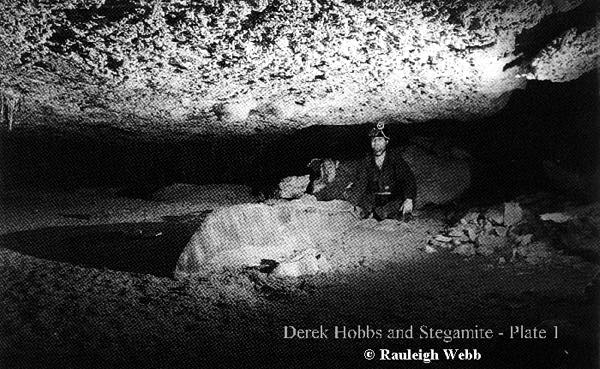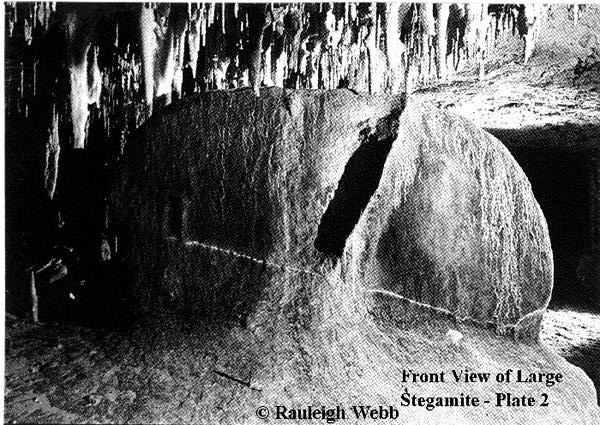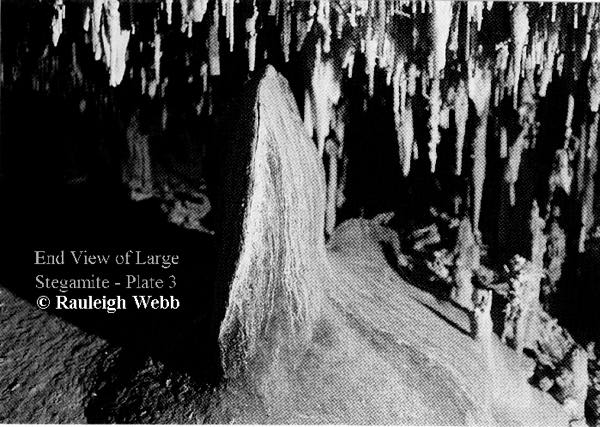Abstract
The description of an unusual speleothem from two caves on the Nullarbor Plain. The name of Stegamite is proposed for the formation as it appears like the ridges on the back of a Stegosaurus.
The dissolution of a broken section of one of the Stegamites in Hydrochloric Acid indicated that the black material was organic in origin.
Theory's for the formation of Stegamites are postulated.
INTRODUCTION
During the first trip to take Ultra-Light aircraft (Trykes) to the Nullarbor Plain to locate caves, the entrance to a new cave was located by the aircraft. This cave was named Matilda (N-370) by the pilot making the discovery. The exploration of Matilda was unusual in that it had not been previously explored except cursorily by Wayne Tyson and "Stubbie" on the day it was found.
Then on the subsequent trip to survey the cave track marking occurred as the cave was explored. Great care was taken to restrict damage to the tracks that were being marked.
It was on this second trip to explore, track mark and survey Matilda and Gorange Cave (N-360) that the unusual ridges in the floors of both caves were noticed. The formations were named Stegamites as they appear as ridges in black calcite floors similar to the ridges on the back of a Stegosaurus.
Description
Stegamites always occurs on the floor of caves in areas where calcite flows covers the floor. To date the speleothems only occur in calcite that is black in colour. An X-ray diffraction examination of a sample of a stegamite indicated 99%+ pure calcite with what appeared to be black organic material.
The stegamites in Plate 1 indicate the average size of the stegamites discovered. The formations range in size from 5cm wide x 5cm high x 30cm long to 1m wide x 1.3m high x 1.6 m long. They appear as a "ridge" in the calcite floor generally with a crack along the top of the "ridge". They do not appear to be aligned within a single sheet of calcite but rather appear at angles random to each other.
Some stegamites appear to have shattered during their formation. In some cases just the top "ridge" of the stegamite has fractured. Examination of this fractured top of the stegamite indicates that it consists of tens of layers of calcite varying in thickness from 1 micron to 2 millimetres. These layers are angled at approximately 45 degrees to the horizontal. They also appear to be horizontally bedded along the length of the formation.
The colour of these layers also varies from white to black. The white layers are generally much smaller in thickness than the much thicker black layers which dominate the formation.
A great deal of work has been done on the colour of speleothems. In particular White (1981) used reflectance spectra to postulate that the commonly held theory that the yellow to brown colouration of speleothems is not due to iron oxides but rather the colouration is probably due to humic substances from the overlying soils.
Furthermore Hill (1982) has examined the origin of a number of the black deposits found in caves. These were broadly grouped into:-
Manganese Deposits
Soot
Guano
and Humate and other carbonaceous matter.
In the case of stegamites and other black speleothems in Matilda and Gorange caves the black colouration is thought to be organic in nature as the colour is taken up in chloroform once the bulk of the sample has been dissolved in acid. Further tests will be performed to determine the exact nature of the black material.
One unusual stegamite shown front on (Plate 2) and side on (Plate 3) appears to resemble a large shell. It is approximately 1.2 metres high x 1.5 metres long x 0.25 metres thick.
Cave Shields
The only other formation that may be related to stegamites are cave shields. Shields consist of two oval or circular parallel plates (this may resemble the stegamite shown in Plate 2) which are separated by a medial crack. The shield is formed by solutions being forced from the medial capillary crack at the rim of the shield. Shields can occur on floors, cave walls or ceilings with the calcite deposited in concentrically arranged crystalline zones (Hill 1986).
A very interesting theory for how the shield keeps its medial crack open was postulated by Moore (1958) and later Schmidt (1963). This theory proposes that action of the earth's tides effect the water flows in the medial crack and ensures that it remains open.
Proposed Theory for the Formation of Stegamites
It is proposed that stegamites are formed in a manner similar to cave shields in that solutions are forced through a crack or joint in the floor. However they differ from cave shields in that concentric plates are not formed.
Instead the solution is thought to be forced through the crack and flow across the floor forming the calcite sheet. During this process the "ridge" is forming in the floor much like a volcano with the lava (solution) pouring over the rim of the cone ("ridge").
However in the case of stegamites, as the flow is from a crack in the floor, the flow forms ridges instead of a volcano shape.
In two cases, secondary stegamites appear to have formed on the original speleothem. In Plate 2 a small secondary stegamite appears on the side of the larger formation. This is probably the result of the medial crack closing but the solution finding its way through the weakest section of the formation, forcing a new crack in the side of the original stegamite. It should be noted that these secondary stegamites were only observed on the two largest stegamites, the one shown in Plate 2 and another in Matilda.
The major differentiation between stegamites and shields is the lack of concentrically arranged plates in stegamites. They appear to comprise of horizontal layers of calcite and hence are clearly not formed in the same manner as shields.
The complete absence of black material in the thin white layers in stegamites clearly indicate short term variations in the climatic conditions during the deposition of calcite.
Plates
References
Hill C.A. (1982) Origin of Black Deposits in Caves, NSS Bulletin, 44:15-19.
Hill C.A. and Forti P. (1986) Cave Minerals of the World, NSS, Huntsville, ALABAMA. pp 57-59.
Moore G. W. (1958) Role of earth tides in the formation of disc-shaped cave deposits, NSS News, V16:11, p113-114.
Schmidt V. (1963) Shields, joints and earth tides, Netherworld News, V6:1, p115-120.
White (1981) Reflectance Spectra and Color in Speleothems, NSS Bulletin, 43: 20-26.
©1995 Rauleigh Webb Last modified 24 August 1995




